A Development of Meso-Scale Vortex Combustion for a Micro Power Generator Based on a Thermoelectric Generator
Abstract
1. Introduction
2. Experimental Setup
Numerical Model
3. Results and Discussion
3.1. Numerical Simulation Results
3.2. Flame Appearance
3.3. Temperature Measurement
3.4. Power Output Measurement
4. Conclusions
- Based on the simulation results for the vertical and horizontal vortex combustors, the flame temperature of the horizontal combustor made from stainless steel had the highest flame temperature.
- Based on the simulation results for the vertical and horizontal vortex combustors, the wall temperature of the horizontal combustor made from stainless material had the highest wall temperature; the thermal conductivity of aluminum was better than stainless steel.
- Based on the experimental results for the vertical and horizontal vortex combustors, the horizontal vortex combustor had a higher temperature than the vertical vortex combustor. In regard to the material, the horizontal combustor made with stainless steel had a higher wall temperature.
- To analyze the electric energy generated from the meso-scale vortex combustor, the stainless material horizontal combustor was selected. According to the results, two TEGs with a series circuit using a water-cooled system had higher energy output than the other options; this combustor can generate at least 3.6 watts.
Author Contributions
Funding
Data Availability Statement
Conflicts of Interest
References
- Walther, D.C.; Ahn, J. Advances and challenges in the development of power-generation systems at small scales. Prog. Energy Combust. Sci. 2011, 37, 583–610. [Google Scholar] [CrossRef]
- Ju, Y.; Maruta, K. Microscale combustion: Technology development and fundamental research. Prog. Energy Combust. Sci. 2011, 37, 669–715. [Google Scholar] [CrossRef]
- Chou, S.; Yang, W.; Li, J.; Li, Z. Porous media combustion for micro thermophotovoltaic system applications. Appl. Energy 2010, 87, 2862–2867. [Google Scholar] [CrossRef]
- Yang, W.M.; Chou, S.K.; Shu, C.; Li, Z.W.; Xue, H. Development of microthermophotovoltaic system. Appl. Phys. Lett. 2002, 81, 5255–5257. [Google Scholar] [CrossRef]
- Fernandez-Pello, A.C. Micropower generation using combustion: Issues and approaches. Proc. Combust. Inst. 2002, 29, 883–899. [Google Scholar] [CrossRef]
- Jiaqiang, E.; Luo, B.; Han, D.; Chen, J.; Liao, G.; Zhang, F.; Ding, J. A comprehensive review on performance improvement of micro energy mechanical system: Heat transfer, micro combustion and energy conversion. Energy 2022, 239, 122509. [Google Scholar] [CrossRef]
- Lee, S.; Um, D.; Kwon, O. Performance of a micro-thermophotovoltaic power system using an ammonia-hydrogen blend-fueled micro-emitter. Int. J. Hydrogen Energy 2013, 38, 9330–9342. [Google Scholar] [CrossRef]
- Li, Y.-H.; Hong, J.R. Power generation performance of hydrogen-fueled micro thermophotovoltaic reactor. Int. J. Hydrogen Energy 2018, 43, 1459–1469. [Google Scholar] [CrossRef]
- Wang, W.; Zhao, Z.; Kuang, N.; Chen, H.; Liu, J.; Zuo, Z. Experimental study and optimization of a combustion-based micro thermoelectric generator. Appl. Therm. Eng. 2020, 181, 115431. [Google Scholar] [CrossRef]
- Kuo, C.; Ronney, P. Numerical modeling of non-adiabatic heat-recirculating combustors. Proc. Combust. Inst. 2007, 31, 3277–3284. [Google Scholar] [CrossRef]
- Tang, A.; Cai, T.; Huang, Q.; Deng, J.; Pan, J. Numerical study on energy conversion performance of micro-thermophotovoltaic system adopting a heat recirculation micro-combustor. Fuel Process. Technol. 2018, 180, 23–31. [Google Scholar] [CrossRef]
- Khandelwal, B.; Deshpande, A.A.; Kumar, S. Experimental studies on flame stabilization in a three step rearward facing configuration based micro channel combustor. Appl. Therm. Eng. 2013, 58, 363–368. [Google Scholar] [CrossRef]
- Mikami, M.; Maeda, Y.; Matsui, K.; Seo, T.; Yuliati, L. Combustion of gaseous and liquid fuels in meso-scale tubes with wire mesh. Proc. Combust. Inst. 2013, 34, 3387–3394. [Google Scholar] [CrossRef]
- Saputro, H.; Ariyanto, E.D.; Wijayanto, D.S.; Muslim, R.; Fitriana, L.; A Munir, F. An experimental study into the effect of fuel on step micro-combustor to the flame stability characterization. J. Phys. Conf. Ser. 2021, 1808, 012020. [Google Scholar] [CrossRef]
- Saputro, H.; Purwanto, A.; Fitriana, L.; Wijayanto, D.S.; Sutrisno, V.L.P.; Ariyanto, E.D.; Bima, M.; Pratama, Y.; Juwantono, H.; Firdani, T.; et al. Analysis of flame stabilization limit in a cylindrical of step micro-combustor with different material through the numerical simulation. MATEC Web Conf. 2018, 197, 08003. [Google Scholar] [CrossRef]
- Saputro, H.; Bima, M.; Fitriana, L.; Wijayanto, D.S.; Bugis, H.; Munir, F.A. Optimization of thermal energy of cylindrical micro-combustor by using the different materials. In Proceedings of the 7th Mechanical Engineering Research Day (MERD'20)—Kampus Teknologi UTeM, Virtual, 16 December 2020. [Google Scholar]
- Abdul Munir, F.; Muazzam, M.I.; Gader, A.; Mikami, M.; Saputro, H.; Fitriana, L. Effects of Wall Thickness on Flame Stabilization Limits for Combustors with Wire Mesh. J. Adv. Res. Fluid Mech. Therm. Sci. 2020, 49, 11–17. [Google Scholar]
- Munir, F.A.; Mikami, M. A numerical study of propane-air combustion in meso-scale tube combustors with concentric rings. J. Therm. Sci. Technol. 2015, 10, JTST0008. [Google Scholar] [CrossRef]
- Tan, N.D.M.R.; Munir, F.A.; Tahir, M.M.; Saputro, H.; Mikami, M. Preliminary Investigation of Using DBD Plasma for Application in Micro Combustors. J. Adv. Res. Fluid Mech. Therm. Sci. 2021, 82, 105–112. [Google Scholar] [CrossRef]
- Shimokuri, D. Autonomous Power System Using Small Scale Vortex Combustor. J. Phys. Conf. Ser. 2018, 1052, 012003. [Google Scholar] [CrossRef]
- Shimokuri, D.; Hara, T.; Ishizuka, S. Development of a portable power system with meso-scale vortex combustor and thermo-electric device. J. Phys. Conf. Ser. 2014, 557, 012117. [Google Scholar] [CrossRef]
- Shimokuri, D.; Taomoto, Y.; Matsumoto, R. Development of a powerful miniature power system with a meso-scale vortex combustor. Proc. Combust. Inst. 2017, 36, 4253–4260. [Google Scholar] [CrossRef]
- Wu, M.-H.; Wang, Y.; Yang, V.; Yetter, R.A. Combustion in meso-scale vortex chambers. Proc. Combust. Inst. 2007, 31, 3235–3242. [Google Scholar] [CrossRef]
- Aravind, B.; Raghuram, G.K.; Kishore, V.R.; Kumar, S. Compact design of planar stepped micro combustor for portable thermoelectric power generation. Energy Convers. Manag. 2018, 156, 224–234. [Google Scholar] [CrossRef]
- Saputro, H.; Juwantono, H.; Bugis, H.; Wijayanto, D.S.; Fitriana, L.; Perdana, V.L.; Purwanto, A.; Arianto, E.D.; Bima, M.; Pratama, Y.; et al. Numerical simulation of flame stabilization in meso-scale vortex combustion. MATEC Web Conf. 2018, 197, 08005. [Google Scholar] [CrossRef][Green Version]
- Ben Khedher, N.; Selimefendigil, F.; Kolsi, L.; Aich, W.; Ben Said, L.; Boukholda, I. Performance Optimization of a Thermoelectric Device by Using a Shear Thinning Nanofluid and Rotating Cylinder in a Cavity with Ventilation Ports. Mathematics 2022, 10, 1075. [Google Scholar] [CrossRef]
- ANSYS Inc. ANSYS Fluent Theory Guide Release 15; ANSYS Inc.: Canonsburg, PA, USA, 2013. [Google Scholar]
- Li, J.; Chou, S.; Yang, W.; Li, Z. A numerical study on premixed micro-combustion of CH4–air mixture: Effects of combustor size, geometry and boundary conditions on flame temperature. Chem. Eng. J. 2009, 150, 213–222. [Google Scholar] [CrossRef]
- Westbrook, C.K.; Dryer, F.L. Simplified Reaction Mechanisms for the Oxidation of Hydrocarbon Fuels in Flames. Combust. Sci. Technol. 1981, 27, 31–43. [Google Scholar] [CrossRef]


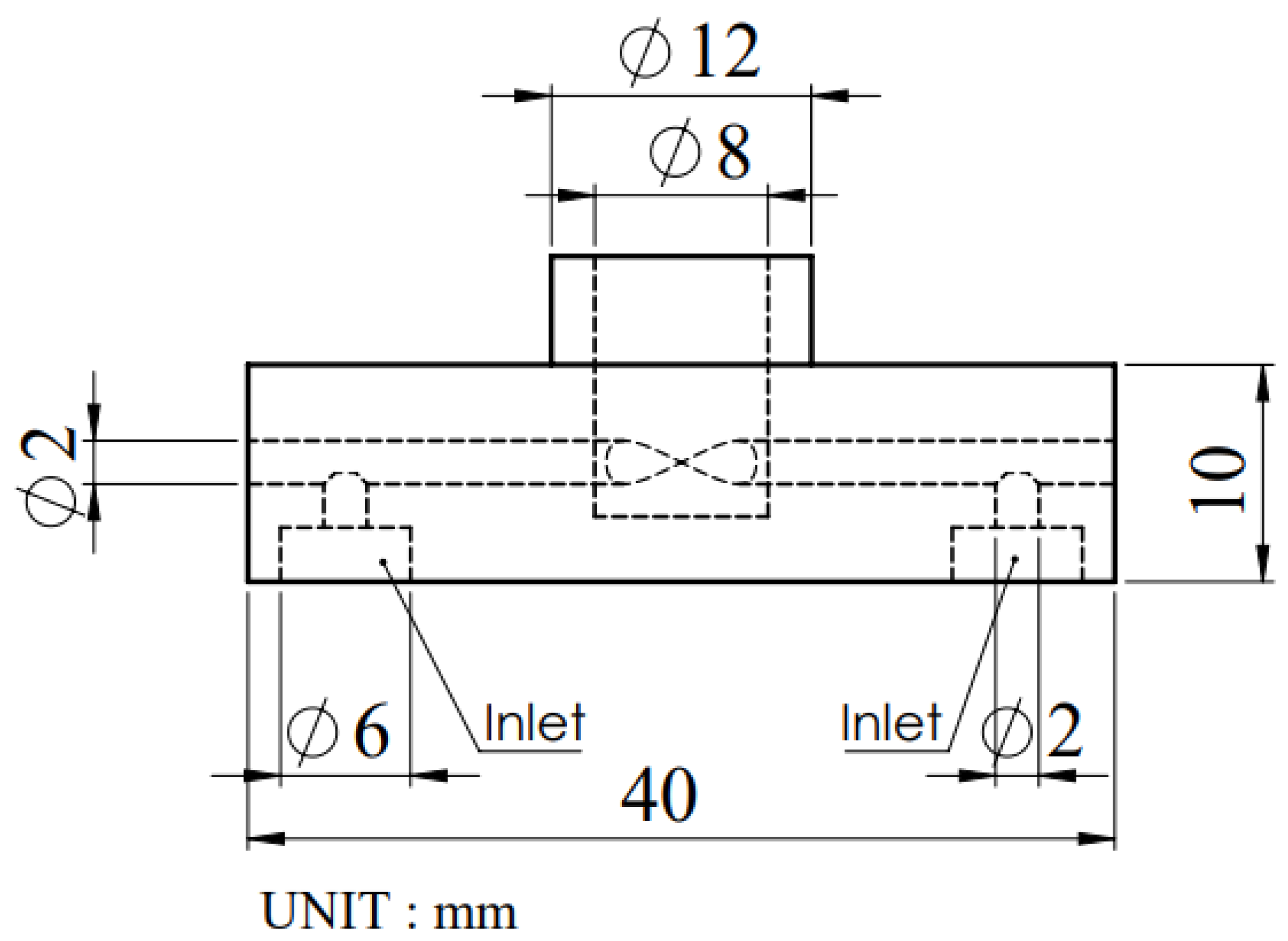
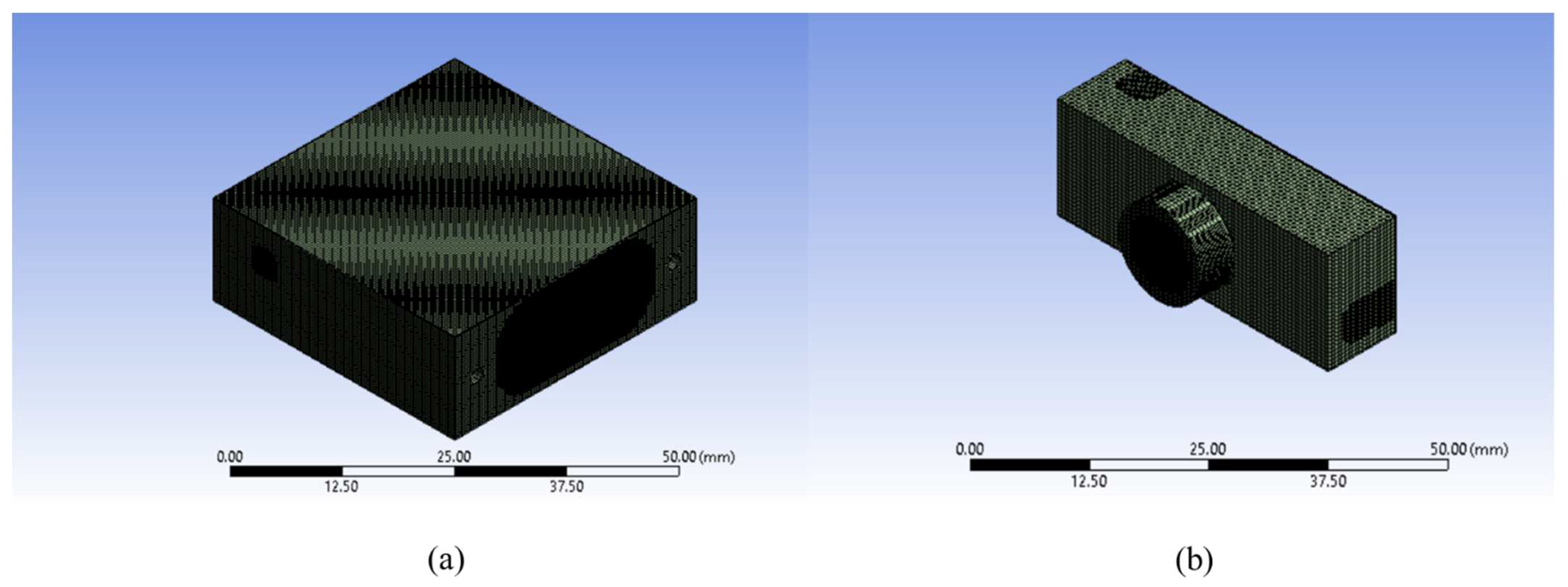


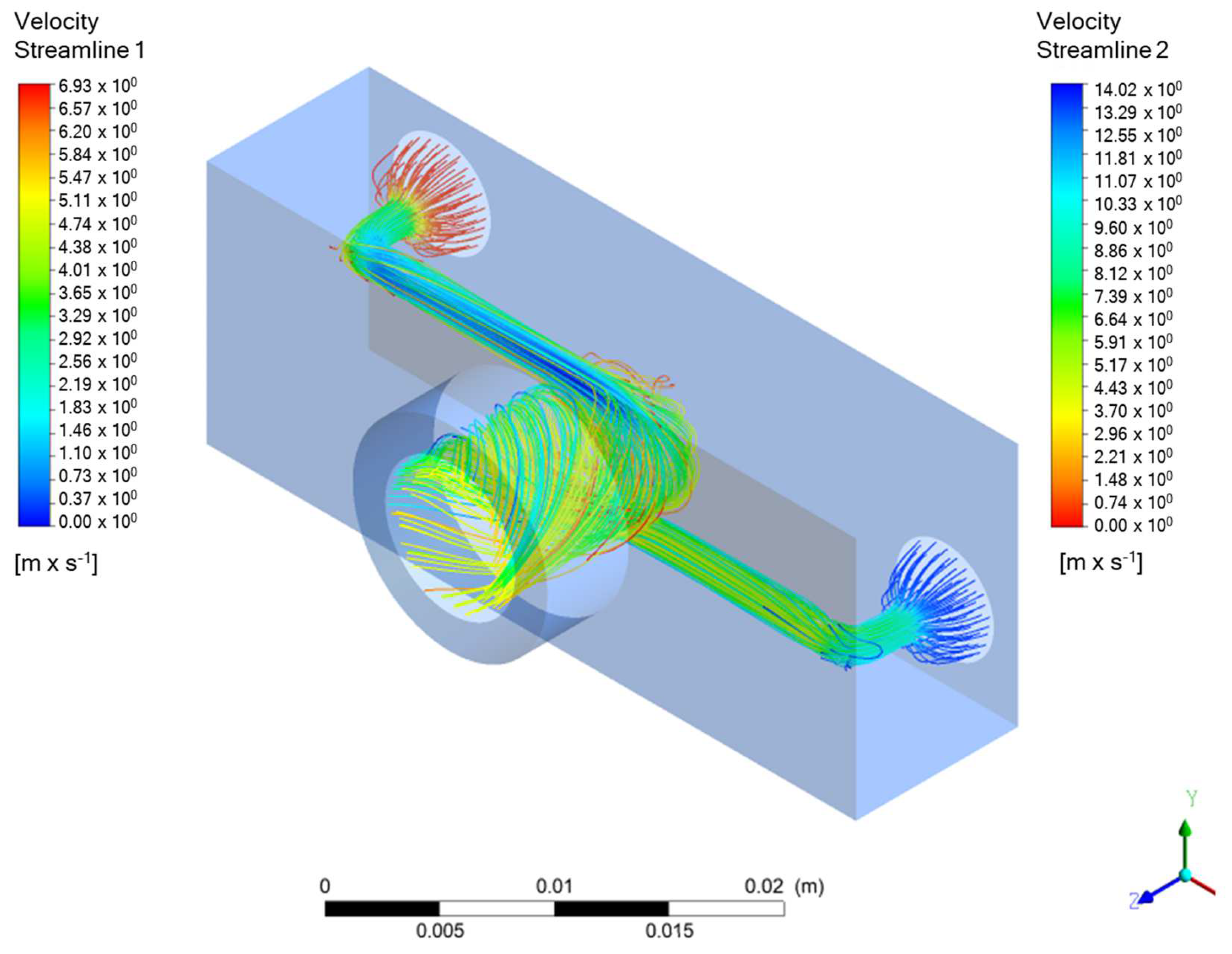


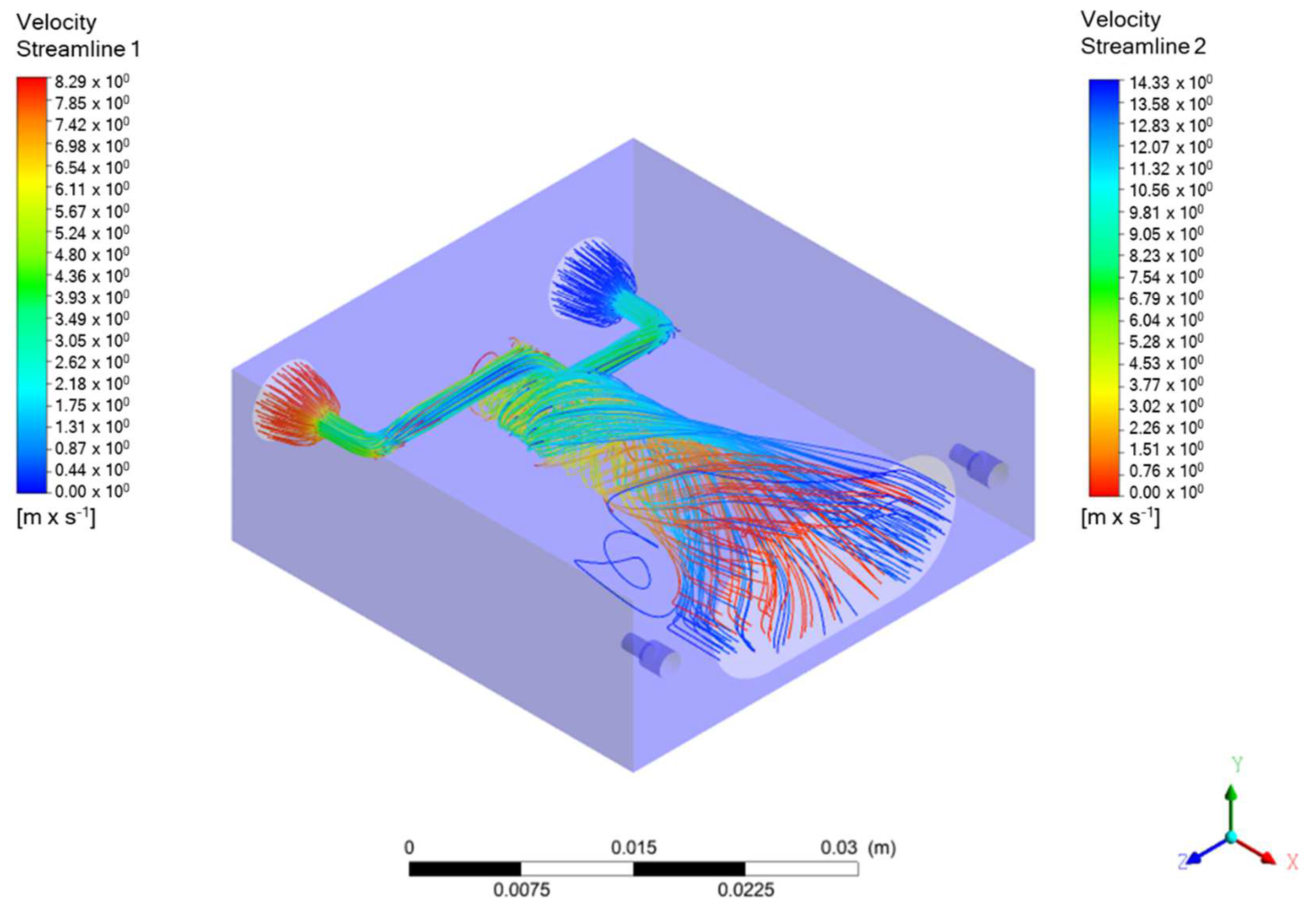



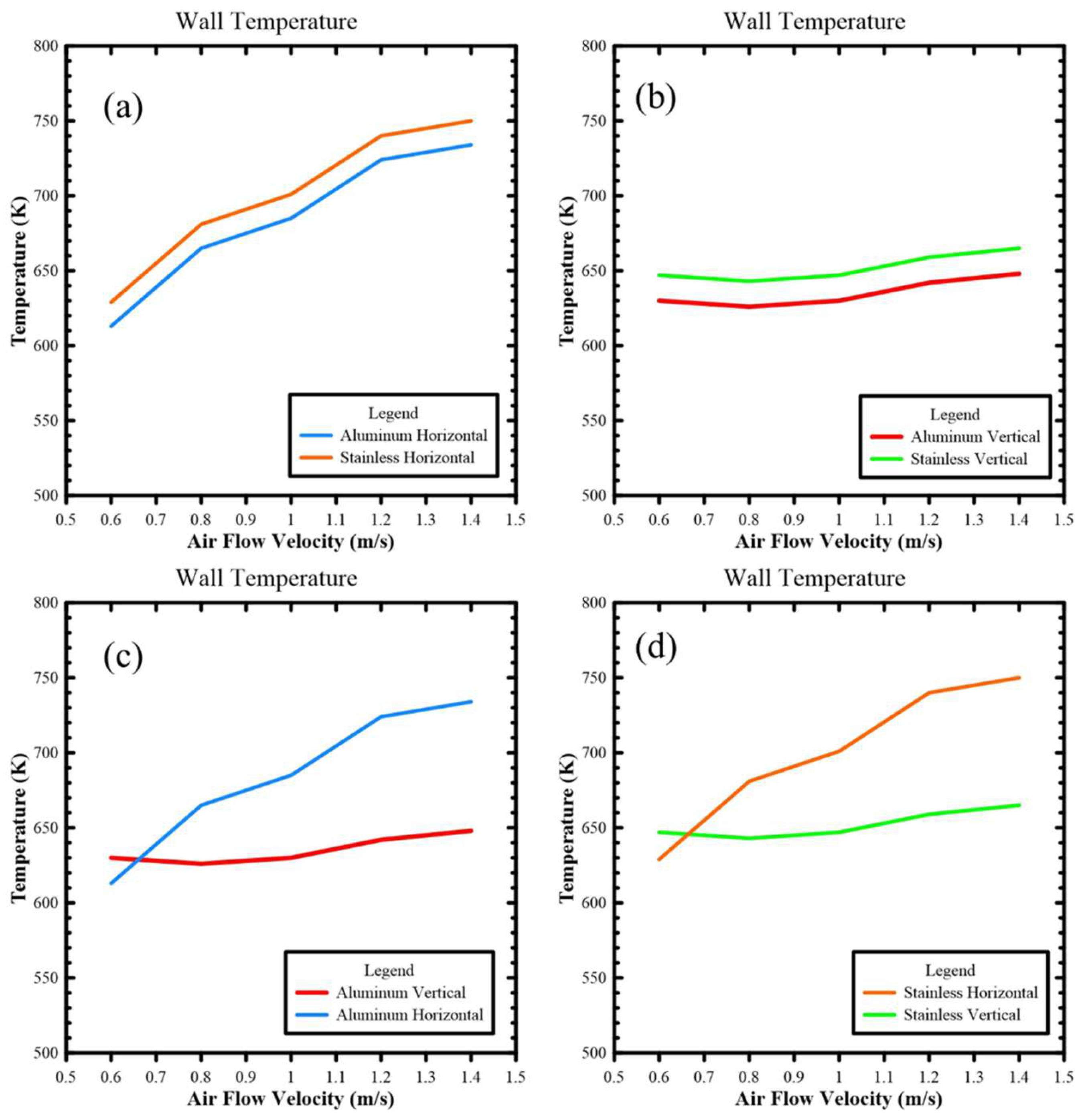


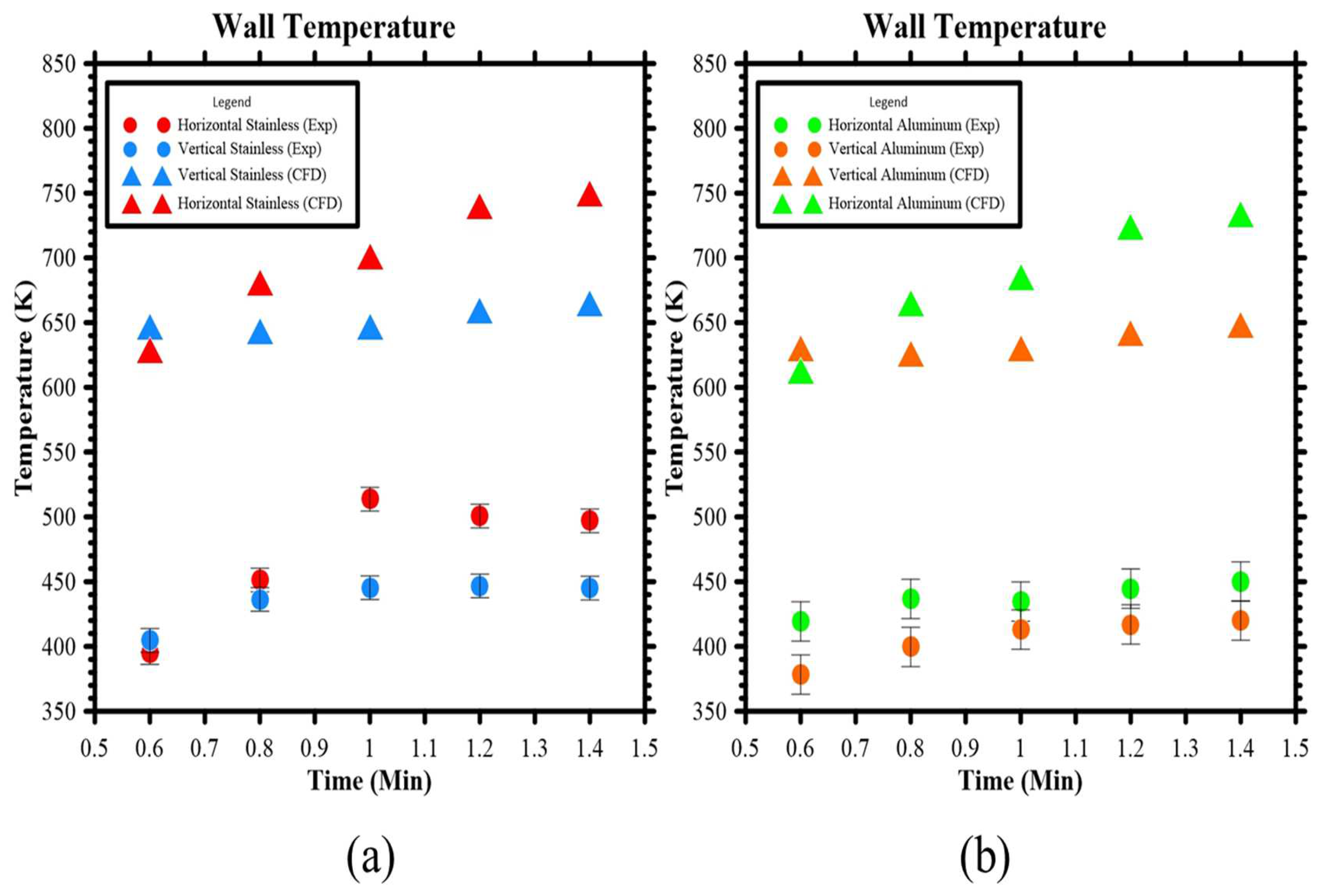
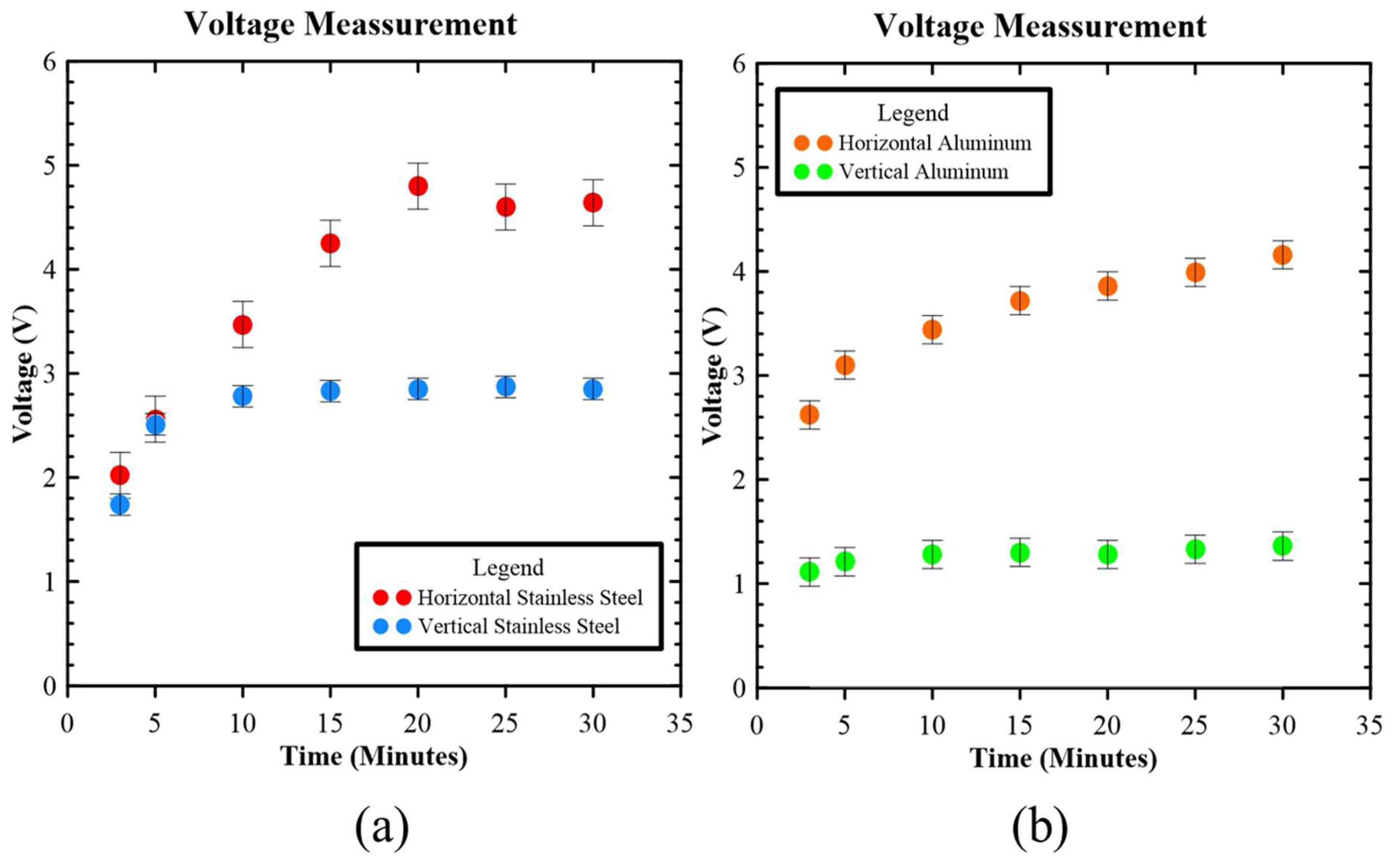

| Boundary | Variable | Value |
|---|---|---|
| Inlet | Oxidizer Velocity (m/s) | 0.6–1.4 |
| Fuel Velocity (m/s) | 0.2 | |
| Temperature (K) | 300 | |
| Species Mole Fraction | 1 for C3H8 | |
| 0.21 for O2 | ||
| Gauge Pressure (Pa) | 0 | |
| Hydraulic Diameter (mm) | 6 | |
| Outlet | Species Mole Fraction | 0.21 for O2 |
| Temperature (K) | 300 | |
| Gauge Pressure (Pa) | 0 | |
| Hydraulic Diameter (mm) | 8 | |
| Outer Wall | Thermal Condition | Mixed |
| Heat Transfer Coefficient (W/(m2·K)) | 5 | |
| Material | Stainless Steel | |
| Aluminum |
| Name | Voltage (V) | Ampere (A) | Power (Watt) |
|---|---|---|---|
| Single Water | 3.791 | 0.6 | 2.275 |
| Single Coolant | 3.580 | 0.6 | 2.148 |
| Parallel Water | 3.346 | 0.6 | 2.007 |
| Parallel Coolant | 3.079 | 0.6 | 1.847 |
| Series Water | 6.023 | 0.6 | 3.614 |
| Series Coolant | 4.984 | 0.6 | 2.991 |
Publisher’s Note: MDPI stays neutral with regard to jurisdictional claims in published maps and institutional affiliations. |
© 2022 by the authors. Licensee MDPI, Basel, Switzerland. This article is an open access article distributed under the terms and conditions of the Creative Commons Attribution (CC BY) license (https://creativecommons.org/licenses/by/4.0/).
Share and Cite
Saputro, H.; Fitriana, L.; Purwanto, A.; Munir, F.A.; Wang, W.-C. A Development of Meso-Scale Vortex Combustion for a Micro Power Generator Based on a Thermoelectric Generator. Fluids 2022, 7, 386. https://doi.org/10.3390/fluids7120386
Saputro H, Fitriana L, Purwanto A, Munir FA, Wang W-C. A Development of Meso-Scale Vortex Combustion for a Micro Power Generator Based on a Thermoelectric Generator. Fluids. 2022; 7(12):386. https://doi.org/10.3390/fluids7120386
Chicago/Turabian StyleSaputro, Herman, Laila Fitriana, Aris Purwanto, Fudhail A Munir, and Wei-Cheng Wang. 2022. "A Development of Meso-Scale Vortex Combustion for a Micro Power Generator Based on a Thermoelectric Generator" Fluids 7, no. 12: 386. https://doi.org/10.3390/fluids7120386
APA StyleSaputro, H., Fitriana, L., Purwanto, A., Munir, F. A., & Wang, W.-C. (2022). A Development of Meso-Scale Vortex Combustion for a Micro Power Generator Based on a Thermoelectric Generator. Fluids, 7(12), 386. https://doi.org/10.3390/fluids7120386








